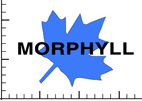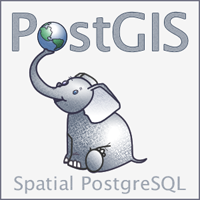Applied Methods
The data gathered within this project has been processed by several successive steps starting with image acquisition of fossil leaves followed by image processing, leaf shape extraction, calculation of leaf morphometric parameters and data providing.
All compiled data and the database itself were as far as possible generated by using open source software.
Image acquisition
If the preservation status of the fossils was suitable the leaves were scanned using a
Canon CanoScan-5600F which is characterised by a high depth of field.
Otherwise, fossil leaves were photographed from a copystand using a
Nikon-D5100.
In photographic pictures a scale bar was mounted in the focal plane of the leaf lamina.
Image processing
The images were rotated in order to align the main parts of the primary (central) leaf vein vertically.
After contrast adaptation the images were resized to real object size with the help of the scale bar, that is the dimensions of the images correspond to the real size of the fossil leaf.
Leaf shape extraction
In order to calculate leaf morphometric parameters of individual fossils the leaf outlines were digitised in
QuantumGIS an open source geographic information system.
For this purpose the images of fossil leaves were georeferenced to the upper most part of the leaf petiole (if preserved in the fossil).
Thus, all leaf images can superimposed at this "origin" due to fact that it is a homotop landmark in angiosperm leaves.
The leaf outlines of fossils were digitised by hand in order to generate shapefiles - a popular geospatial vector data format in GIS.
Owing to the fact that nearly all fossil leaves are fragmented and thus some parts of the lamina are not preserved for each leaf two versions of outlines were generated (cf. main page):
(1) A minimum outline representing unequivocally parts of the
fragmented lamina and
(2) a maximum outline representing the complete
replenished lamina, which is of course a subjective interpretation of the lamina shape.
Calculation of leaf morphometric parameters
The calculation of leaf morphometric parameters such as leaf area are performed by spatial SQL-queries.
For this purpose the shapefiles of leaf outlines were imported to a object-relational
PostgreSQL-database with
PostGIS extension which adds support for spatial queries to be run in SQL.
For example the leaf area of a leaf outline is requested in SQL with:
SELECT ST_Area (the_geom) FROM shapefile_name ;
The argument "the_geom" comprise the geometric information (coordinates) of the leaf shape outlines.
Several quantitative morphometric parameters are extracted from leaf outlines: Lamina area, perimeter, leaf length, -width, leaf length/width ratio, lamina centroid and lamina circularity.
The calculations of leaf length and width are based on the bounding box of the leaf outlines.
In addition to these quantitative morphometric parameters several qualitative leaf shape and venation descriptors were determined for each fossil using the
Manual of Leaf Architecture (Ellis et al. 2009) as standard.
Data handling/providing
The quantitative and qualitative data are stored and managed in
PostgreSQL 9.1.16.
All data are available by filtering individual queries (see menu "Database - Ouery").
Although both, morphometric data of fragmented and replenished leaves are stored in the database only morphometries of replenished leaf outlines are provided for public.
Prospective the images of fossil leaves as well their generated outlines are also available via a "map"-frame provided by
GeoServer using map server techniques such as
Web Map Service (WMS) and
Web Coverage Service (WCS) (see main page).







